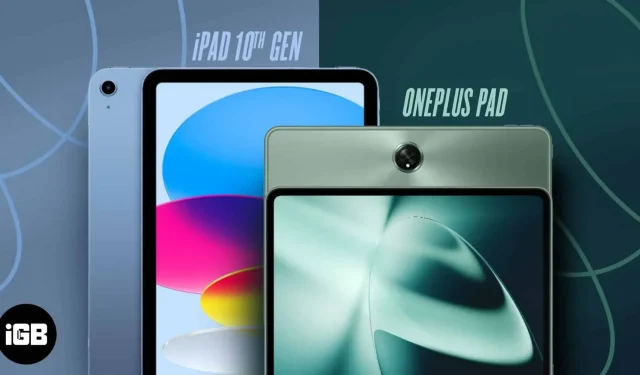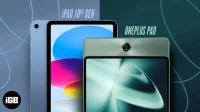The tablet market has been dominated by a small number of major companies, with Apple’s iPad taking the lead. Despite this, other producers continue to make an effort to stand themselves in the market. One such newcomer is OnePlus.
Although OnePlus has introduced a number of smartphones, its most recent product marks the company’s entry into the Android tablet market. No Android tablet has been able to match the performance of an Apple tablet up until this point. Would the OnePlus Pad, which is new, be able to compete with the iPad (10th generation)? Seeing how the two tablets compare will help us decide which is best for you.
OnePlus Pad vs. iPad (10th gen) – Specifications
Look at the fundamental specifications the two tablets may provide before we go into the details.
| OnePlus Pad | iPad (10th generation) | |
| Size | 10.2 x 7.5 x 0.3 inches (258 x 189.4 x 6.5mm) | 9.79 x 7.07 x 0.28 inches (248.6 x 179.5 x 7mm) |
| Weight | 552g | 477g (Wi-Fi) 481g (Wi-Fi + Cellular) |
| Display | 11.6 inches (2800×2000 pixels), 144 Hz Display | 10.9 inch (2360×1640 pixels) Liquid Retina display |
| OS | Android 13 (OxygenOS 13.1) | iPadOS 16 |
| CPU | MediaTek Dimensity 9000 | A14 Bionic Chip |
| Storage | 8GB LPDDR5 RAM; 128GB | 4GB LPDDR4X RAM; 64GB, 256 GB |
| Colors | Halo Green | Silver, Blue, Pink, Yellow |
| Ports | USB-C | USB-C |
| Cameras | 8MP front, 13 MP rear | 12 MP front and rear |
| Battery life | 9,510mAh Battery, 67W SuperVooc;Up to 12.5 hours | 28.6 Wh lithium‑polymer;Up to 10 hours |
| Price | $479 | $449 (64GB), $599 (256GB) |
OnePlus Pad vs. iPad (10th generation): Aesthetics
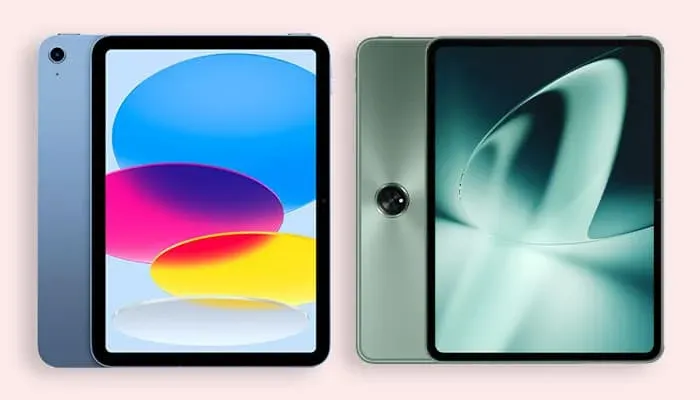
These tablets include a glass front and an aluminum back for a contemporary, streamlined look.
Each have speaker cutouts, power and volume controls. In the iPad 10th generation, Apple did away with the outdated Home button, giving users a screen that is almost edge to edge but still has a bezel around the edges. Another benefit is the iPad’s Power button, which has Touch ID integrated in. This makes unlocking and making transactions very quick.
Moreover, the iPad features straight sides like the iPad Air and Pro ranges, doing away with the curved edges that come with its predecessors, giving it a clean, contemporary appearance. The OnePlus Pad, in comparison, features curved edges along its sides and bottom, making it more ergonomic and cozy to grasp. Both tablets are light and small, and the weight difference is negligible.
The OnePlus Pad’s big 13MP rear camera is one glaring design change. The tablet is shipped with a striking black circle that protrudes, making it impossible for it to sit flat on any surface.
The placement of the camera is also a little strange when the tablet is in portrait mode, but it makes sense when it is held in landscape mode.
You’ll adore the iPad’s selection of Silver, Yellow, Pink, and Yellow if you like bright colors. The OnePlus Pad, in comparison, features a more svelte, regal Green Halo design.
Both tablets no longer have a 3.5mm headphone jack and instead feature USB Type-C ports.
iPad (10th generation) vs. OnePlus Pad: Display
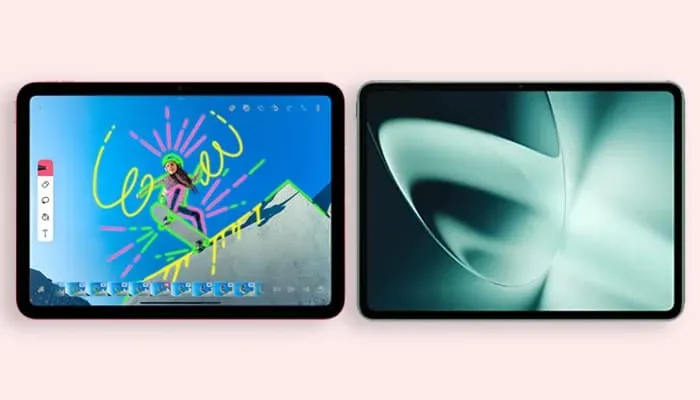
The two tablets’ displays are both similarly brilliant, with a maximum brightness of 500 nits. Yet, the OnePlus tablet has a slight size edge over the iPad thanks to a slightly larger 11.6-inch display.
The OnePlus Pad also boasts about having a 144Hz refresh rate, which the iPad does not offer. Nonetheless, the Apple iPhone still has a 120Hz display that goes by the fancy term of ProMotion.
On paper, this sounds wonderful for the OnePlus Pad, but the viewing experience isn’t significantly different.
OnePlus Pad vs. iPad (10th generation): Performance and power
Given that the two processors operate on distinct platforms, it is challenging to compare their power. The iPad 10th generation is powered by the A14 Bionic processor, whereas the Android tablet has a more recent Dimensity 9000 SoC.
However, benchmark studies reveal that in terms of overall CPU performance and video transcoding tests, the iPad 10th generation outperforms the OnePlus Pad.
This is probably caused by the fact that the iPad, as well as all other Apple devices, have chips built into the Apple ecosystem. You may anticipate a smoother overall experience from the iPad as having hardware paired with its own software ensures a more optimal performance.
Although while the OnePlus Pad has an additional 8GB of RAM compared to the iPad’s 4GB, you probably won’t notice much of a difference in daily use.
Both tablets are capable of handling graphically intensive tasks, but you might enjoy watching videos on the OnePlus Pad’s high refresh rate display more.
Software
The polished feel of the iPad’s fluid user interface, iPad-specific apps, and seamless integration with the Apple ecosystem give it a significant advantage over rival tablets.
Most users also use their tablets as an extra screen for their laptops and desktop computers. This gives the iPad, which successfully integrates with the Mac via the Sidecar feature, a further advantage.
The OnePlus Pad’s user interface could use some improvement to be on par with the iPad’s.
Sound quality
If you’re an audiophile, you might like the OnePlus Pad’s Omnibearing Sound Field technology, which uses its four potent speakers (two on each side when in landscape) to deliver the best sound quality possible in any direction and also supports Dolby Atmos for high-end music quality.
When in landscape mode, the iPad 10th generation has a speaker on each side.
10th generation iPad vs. OnePlus Pad: Camera
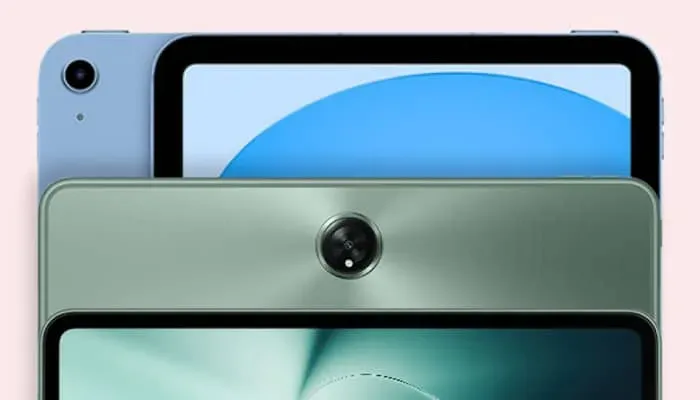
Tablets don’t often require good cameras, although the majority of them are used for online video conferencing for work or school. While the iPad 10th generation features a 12MP front and rear camera, the OnePlus Pad boasts a 13MP rear camera and an 8MP front camera.
This makes either smartphone a great option for snapping photos and participating in video chats.
iPad (10th generation) and OnePlus Pad: Battery Life and Charging
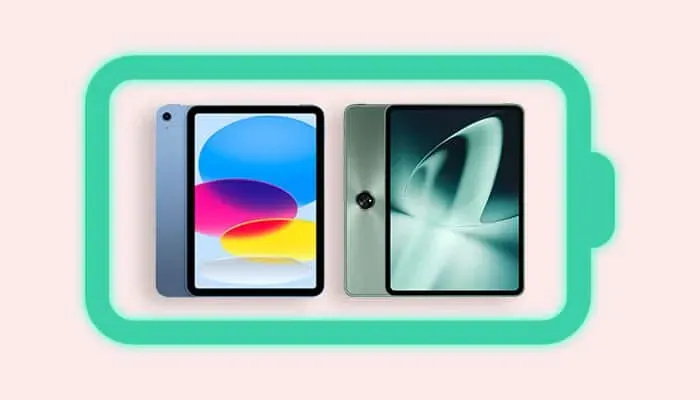
The battery life of the iPad’s 28.6 watt-hours is up to 10 hours of video playback. The 9,510 mAh battery in the OnePlus Pad, meanwhile, allows for up to 12.4 hours of movie playing.
The 67W SUPERVOOC in the OnePlus Pad, which charges completely in under one hour, would be a game-changer. In contrast, the Apple device may take longer to charge from zero to 100 with a 20W connected charging speed.
Assistance with accessories
The OnePlus Pad performs better in terms of charging when it comes to accessories. The fact that the iPad 10th generation only works with the Apple Pencil 1st generation and requires an additional adapter to charge is a major drawback. The OnePlus Pad’s Stylo can be charged by simply snapping it to the flat top piece of the pen.
These tablets are excellent alternatives to notebooks because they both feature a keyboard. While the OnePlus Pad has its own OnePlus Magnetic Keyboard, the iPad works great with its Magic Keyboard Folio.
Both have trackpads and pogo pins for attachment. The Android keyboard resembles an early Apple Smart Keyboard, whereas the Magic Keyboard Folio is made up of two different components.
The OnePlus Magnetic Keyboard has the drawback that it only functions when the tablet is inserted into a slot above the keyboard keys, giving you only one viewing angle.
The Folio, on the other hand, is devoid of an iPad slot. You can prop it up in various viewing positions thanks to this.
iPad (10th generation) vs. OnePlus Pad: Cost and Availability
The iPad is $449 while the OnePlus Pad is $479. The extras can be purchased separately.
The stylus for the OnePlus Pad is $149, while the case is $39. A additional purchase of the Apple Pencil and Folio cover will set you back $99 and $249, respectively.
Here are some more folio cases for the iPad 10th generation that you should look into in addition to the Magic Keyboard Folio.
In 2023, which tablet should you purchase?
The OnePlus Pad, however, might be a better option if you want to buy a tablet for gaming and you care about audio quality and graphics. The OnePlus Pad will also cost you less if money is a key consideration in your choice.
In the end, everything comes down to your wants and preferences. Before choosing a device, thoroughly consider its features. Whatever tablet you choose will be a good one because they are both great options.
